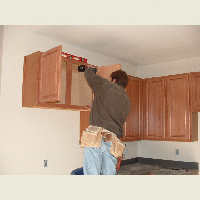Cabinet Installation Tips From A Professional
The process of doing your own cabinet installation will go smother if you apply these tips from a professional installer. Obviously if you do not have some intermediate carpentry skills you should not try installing your own kitchen, vanity or laundry room cabinetry. These should give you some insight into a few of the tools that will be needed, the order of what needs to be completed before mounting the boxes to the walls and also the process of doing the install.
Preparing For The Cabinet Installation
 There are several things that need to be considered as the installer is preparing to install the kitchen, vanity, office or laundry cabinetry. These apply to wall units as well. Keep in mind that when you are preparing to screw the boxes to the wall everything that you are focusing upon is related to things being “plumb, level and square.”
There are several things that need to be considered as the installer is preparing to install the kitchen, vanity, office or laundry cabinetry. These apply to wall units as well. Keep in mind that when you are preparing to screw the boxes to the wall everything that you are focusing upon is related to things being “plumb, level and square.”
Do Not Wallpaper
It is not recommenced to wallpaper before the cabinetry is installed.
Floors Should Not Be Installed
As a general rule the flooring should be installed after the cabinets are put in.
It is important to know what the thickness of the flooring will be. This will determine whether or not you will be able to shim the toe base areas or scribe them to the sub floor. If the floors get put down before the cabinets it will be necessary to finish scribe the toe bases to fit perfectly to the finished floor.
Finish Painting Is OK Before Cabinets are Installed
It’s OK to have the finish coat of paint on the walls that you will be installing on but be advised that there will be touched up afterward. Especially in the areas where caulking is applied between the cabinets and the walls.
High or Low Spots, Dips and Humps in the Flooring and Walls Must be Determined
You must determine what the highest and lowest portion of the floor is and figure out how you will need to install the bases in relation to what the height of the dishwasher is. As an example if you start at the end of a wall and work towards the other end where the dishwasher is going to be and you have to keep cutting off more of the toe base, as you move in that direction, to make the cabinets level, by the time you reach the dishwasher area you may have cut so much off that the dishwasher will not fit underneath the counter. So, to avoid this, you must know exactly what the floor is doing in relation to high and low spots. Using a straight edge or long level check the walls and see if you can determine if there are any large dips or humps that you will have to contend with. Check the up and down to see how plumb they are as well. This is the most important cabinet installation tip of all.
Appliance Sizes and Locations Will Determine The Cabinetry Installation Plan
It’s important to determine how the refrigerator opening and range openings are going to end up in relation to what is happening with your walls and floor. This is where a professional cabinet installer excels in comparison to the “do it yourself” cabinet installer. You have to make sure your openings do not get to small because you had to cut so much off of something. You may have to cut something off of a cabinet in order for the openings to be the proper size. It’s important to make sure that your drawers aren’t going to hit wall casings, or stove and dishwasher handles if you have to make an alteration for things to fit.
These tips should help you when you are preparing for your cabinetry installation. As previously mentioned, a professional installer would be able to assess exactly how all of these things will affect the installation process of your kitchen, office cabinetry, vanities, wall unit of laundry room.

This is a great article, and I appreciate you writing it. I especially enjoyed the part about it being okay to finish painting before installing the cabinets. I get so many questions about hanging cabinets after/before walls have been painted.